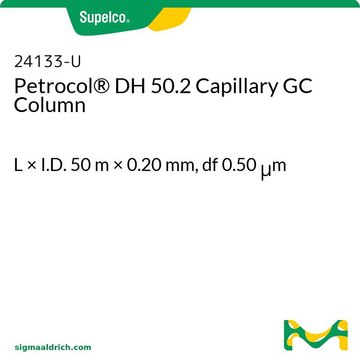24282
Petrocol® DH Octyl
L × I.D. 100 m × 0.25 mm, df 0.50 μm
About This Item
Produits recommandés
Matériaux
fused silica
Agence
ASTM® D6729,D6730,D6773
Paramètres
-60-220 °C temperature (isothermal or programmed)
Valeur bêta
125
df
0.50 μm
Technique(s)
gas chromatography (GC): suitable
L × D.I.
100 m × 0.25 mm
Groupe de la matrice active
Bonded; poly(50% n-octyl/50% methyl siloxane) phase
Application(s)
chemicals and industrial polymers
petroleum
Type de colonne
capillary non-polar
Description générale
USP Code: None
Phase:
- Bonded
- Poly(50% n-octyl/50% methyl siloxane)
- -60 °C to 220 °C (isothermal or programmed)
Autres remarques
Informations légales
Faites votre choix parmi les versions les plus récentes :
Déjà en possession de ce produit ?
Retrouvez la documentation relative aux produits que vous avez récemment achetés dans la Bibliothèque de documents.
Contenu apparenté
Gas chromatography separates volatile compounds in the gas phase, applied in various industries for quality control.
Gas chromatography is a common analytic technique used to separate and analyze volatile compounds in the gas phase. GC is applied in many industries for quality control, and to identify and/or quantify compounds in a mixture.
La chromatographie en phase gazeuse est une technique analytique courante permettant de séparer et d'analyser des composés volatils en phase gazeuse. La GC est appliquée dans de nombreuses industries pour le contrôle qualité, et pour identifier et/ou quantifier les composés d'un mélange.
Notre équipe de scientifiques dispose d'une expérience dans tous les secteurs de la recherche, notamment en sciences de la vie, science des matériaux, synthèse chimique, chromatographie, analyse et dans de nombreux autres domaines..
Contacter notre Service technique